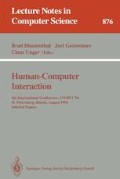Abstract
The paper describes the BOSS-System belonging to the class of model based user interface construction tools, which generate an executable user interface out of a declarative description (model) of an interactive application. BOSS gains a rather high level of usability due to a couple of reasons: BOSS employs an encompassing specification model (HIT, Hierarchic Interaction graph Templates) which allows the declarative description of all parts of the model of an interactive application (application interface, user interaction task space, presentation design rules) in a natural, designer oriented way. BOSS offers an integrated development environment in which user interface designers can elaborate specifications in a graphical, visual-programming-like manner. Through a refinement component, specifications can be refined according to high-level design goals. From a refined specification BOSS generates automatically working user interfaces using modified techniques from compiler construction.
Preview
Unable to display preview. Download preview PDF.
References
H. Balzert. Der JANUS-Dialogexperte: Vom Fachkonzept zur Dialogstruktur. Softwaretechnik 93, 13(3), 11 1993.
L. Bass, C. Cockton, and C. Unger. IFIP Working group 2.7 User Interface Engeneering: A Reference Model for Interactive System Construction. In J. Larson and C. Unger, editors, Engeneering for Human-Computer Interaction. North Holland, 1992.
L. Bass and J. Coutaz. Developing Software for the User Interface. Addison-Wesley, 1991.
F. Bodard, A.M. Hennebert, J.M. Leheureux, I. Sacre, and J. Vanderdonckt. Architecture Elements for Highly-Interactive Business-Oriented Applications. In L. Bass, J. Gornostaev, and C. Unger, editors, Human-Computer Interaction: EWHCI 93 Proceedings. Springer LNCS 753, 8 1993.
D.J.M.J. de Baar and J. Foley. Coupling Application Design and User Interface Design. In ACM CHI 92 Proceedings. ACM, 1992.
P. Deransart, M. Jourdan, and B. Lorho. Attribute Grammars: Definitions, Systems and Bibliography. Springer, 1988.
J. Eickel. Logical and layout structures of documents. Computer Physics Communication 61:201–208, 1990.
J. Foley, W. C. Kim, S. Kovacevic, and K. Murray. UIDE — An Intelligent User Interface Design Enironment. In Intelligent User Interfaces. Addison-Wesley, 1991.
M. Frank and J. Foley. Model-Based Interface Design By Example and By Interview. In Proceedings of the UIST 93, ACM Symposium on User Interface Software and Technology. ACM, 11 1993.
H. Ganzinger. Optimierende Erzeugung von Übersetzerteilen aus implementierung-sorientierten Sprachbeschreibungen. PhD thesis, Technische Universität München, 1978.
C. Janssen, A. Weisbecker, and J. Ziegler. Generating User Interfaces from Data Models and Dialogue Net Specifications. In ACM Interchi 93 Proceedings. ACM, 1993.
P. Johnsen, S. Wilson, C. Kelly, and P. Markopoulos. Beyond hacking: a model based approach to user interface design. In BCS HCI 93 Conference. Cambrigde University Press, 1993.
W.C. Kim and J.D. Foley. Providing High-level Control and Expert Assistance in the User Interface Presentation Design. In ACM INTERCHI '93 Proceedings. ACM, 1993.
J.A. Larson. Interactive Software: Tools for building interactive user interfaces. Prentice Hall, 1992.
S.J. Payne and T.R.G. Greene. Task-Action Grammars: A Model of the Mental Representation of Task Languages. Human-Computer Interaction, 2, 1986.
S. Peretz. ADISSA: Architectural Design of Information Systems based on structured analysis. Information systems, 13(2):193–210, 1988.
W. Schreiber. Prosaische Logik für Dichter und Denker — Textverarbeitung maßgeschneidert. Forschung für Bayern, (6), 1993.
P. Szekely, P. Luo, and R. Neches. Faciliating the Exploration of Design Alternatives: The HUMANOID Model of User Interface Design. In ACM CHI 92 Proceedings. ACM, 1992.
T. Weiske. SICK: Inkrementelle Auswertung von Attributgrammatiken. In G. Snelting, editor, Sprachspezifische Programmierumgebungen: Workshop der Fachgruppe Implementierung von Programmiersprachen, T.H. Darmstadt 6.4–8.4.88, 4 1988.
Author information
Authors and Affiliations
Editor information
Rights and permissions
Copyright information
© 1994 Springer-Verlag Berlin Heidelberg
About this paper
Cite this paper
Schreiber, S. (1994). Specification and generation of user interfaces with the BOSS-System. In: Blumenthal, B., Gornostaev, J., Unger, C. (eds) Human-Computer Interaction. EWHCI 1994. Lecture Notes in Computer Science, vol 876. Springer, Berlin, Heidelberg. https://doi.org/10.1007/3-540-58648-2_30
Download citation
DOI: https://doi.org/10.1007/3-540-58648-2_30
Published:
Publisher Name: Springer, Berlin, Heidelberg
Print ISBN: 978-3-540-58648-7
Online ISBN: 978-3-540-49036-4
eBook Packages: Springer Book Archive

